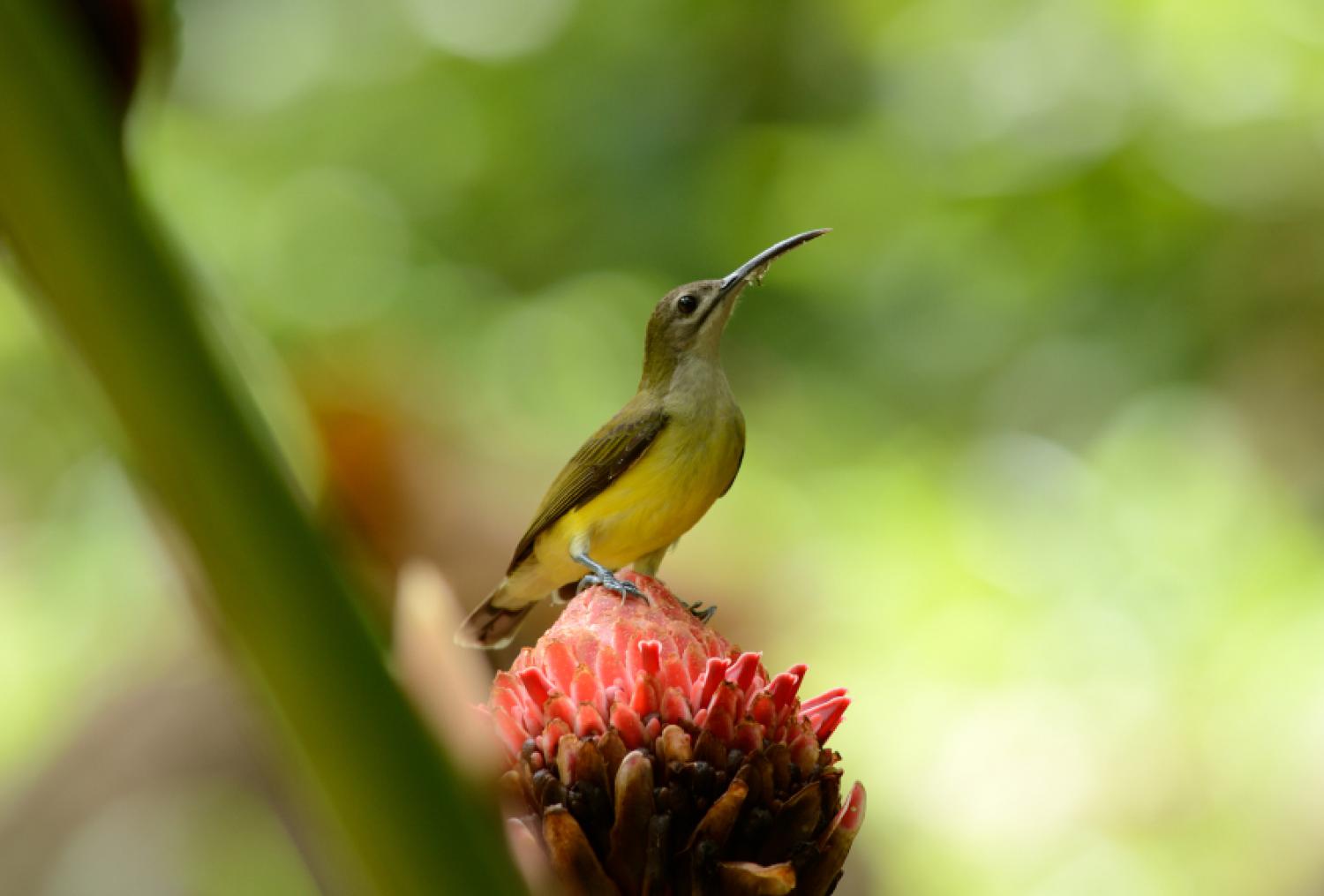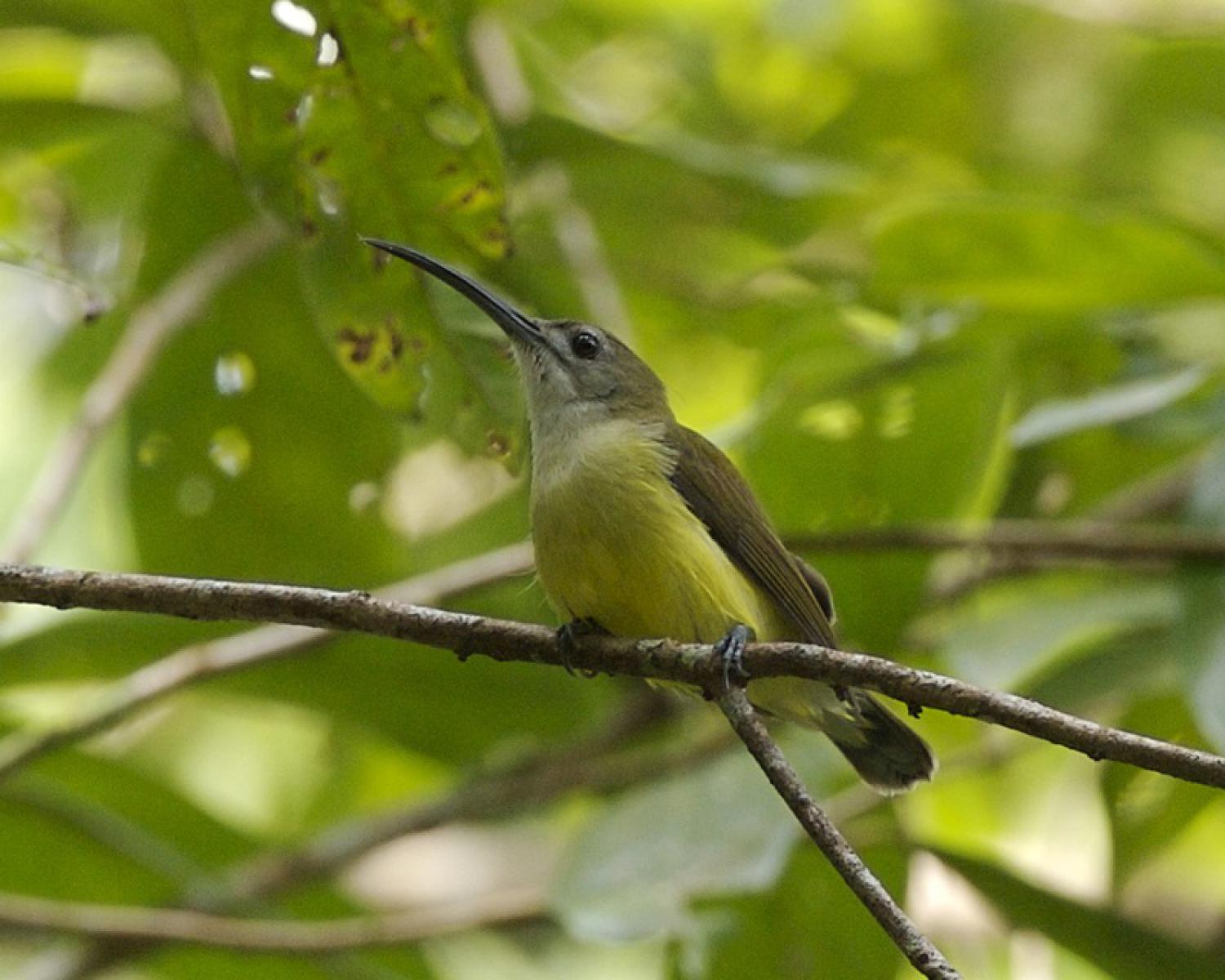Species of Thailand
Little spiderhunter
Arachnothera longirostra
John Aubrey Clarendon Latham, 1790
In Thai: นกปลีกล้วยเล็ก
The little spiderhunter (Arachnothera longirostra) is a species of long-billed nectar-feeding bird in the family Nectariniidae found in the moist forests of South and Southeast Asia. Unlike typical sunbirds, males and females are very similar in plumage. They are usually seen in ones or twos and frequently make a tzeck call and are most often found near flowering plants, where they obtain nectar.
Description
The distinctive long beak set it apart from other sunbirds. The sexes are alike except for a paler base to lower mandible in the female. Male has all black beak. They are found close to their favourite nectar bearing trees, often species of wild Musaceae or flowers in gardens. They have a buzzy zick-zick call that is made regularly when disturbed or when foraging. The song is series of rapid chipping notes and these can go on for long periods.
Taxonomy
The genus name Arachnothera means "spider hunter" and the species epithet refers to the long beak. About thirteen geographic races are recognized. The nominate race longirostra (Latham, 1790) is found in southwestern India, central and northeastern India, foothills of the Himalayas and into Thailand and Yunnan. Race sordida La Touche, 1921 is found in southern China and northeastern Thailand. Race pallida Delacour, 1932 is found in eastern Thailand and C & S Indochina. Two species from the Philippines, the orange-tufted and the pale spiderhunter were formerly considered subspecies. Several other island forms are noted:
- cinireicollis (Vieillot, 1819) - south of the Isthmus of Kra to Sumatra and satellite islands
- zarhina Oberholser, 1912 - Banyak Is, off W Sumatra.
- niasensis van Oort, 1910 - Nias I, off W Sumatra.
- rothschildi van Oort, 1910 - N Natuna Is.
- atita Oberholser, 1932 - S Natuna Is.
- buettikoferi van Oort, 1910 - Borneo.
- prillwitzi Hartert, 1901 - Java (including Madura I) and Bali
- randi Salomonsen, 1953 - Basilan (off W Mindanao).
Distribution and habitat
The species is found in Bangladesh, Bhutan, Brunei, Cambodia, China, India, Indonesia, Laos, Malaysia, Myanmar, Nepal, Philippines, Thailand, and Vietnam. Within India, there are disjunct populations in the Eastern Ghats from Lamasinghi, Visakhapatnam and parts of Orissa) and the Western Ghats apart from the main distribution in north-east India that extends into Southeast Asia. A record from the Nicobar Islands is considered doubtful.
Its natural habitats are subtropical or tropical moist lowland forests, subtropical or tropical mangrove forests, and subtropical or tropical moist montane forests. It is usually found below the canopy. They are also found in gardens, attracted especially by flowers that yield nectar.
Behaviour and ecology
They have been noted as good pollinators of wild banana species and several species of the ginger family and often visit Loranthus sp. (= Dendrophthoe sp.), Indian silk cotton tree and Indian coral tree for nectar. They are often seen in plantations in forest areas. Although they are more often seen in secondary forests or in clearings and appear to be tolerant of human activities, they have become extinct in some forest fragments. In Singapore they have gone locally extinct within the botanical garden.
The breeding season in northeastern India is March to September but mainly May to August. In southern India it breeds from December to August. Two eggs are the usual clutch. The nest is a compact cup attached under a leaf of banana or similar broad leaved plant. The nest is suspended from the underside of the leaf using 150 or so "pop-rivets" of cobwebs and vegetable fibre, a unique method of using spider silk for animal architecture.
It is suspected that Hodgson's hawk-cuckoo and violet cuckoo are brood parasites on this species in India.
A species of haemosporidian, Leucocytozoon, has been noted in specimens from Malaysia.
In culture
In Sarawak, the Kayan, Kenyah and Punan people consider it a bird of good omen and when they are out collecting camphor, the men would wait until they heard the sit call of one of these spiderhunters.
This article uses material from Wikipedia released under the Creative Commons Attribution-Share-Alike Licence 3.0. Eventual photos shown in this page may or may not be from Wikipedia, please see the license details for photos in photo by-lines.
Category / Seasonal Status
BCST Category: Recorded in an apparently wild state within the last 50 years
BCST Seasonal status: Resident or presumed resident
Scientific classification
- Kingdom
- Animalia
- Phylum
- Chordata
- Class
- Aves
- Order
- Passeriformes
- Family
- Nectariniidae
- Genus
- Arachnothera
- Species
- Arachnothera longirostra
Common names
- Thai: นกปลีกล้วยเล็ก
Conservation status

Least Concern (IUCN3.1)
Photos
Please help us review the bird photos if wrong ones are used. We can be reached via our contact us page.
Range Map

- Ao Phang-Nga National Park
- Bang Lang National Park
- Chae Son National Park
- Chaloem Rattanakosin National Park
- Chat Trakan Waterfall National Park
- Chiang Dao District, Chiang Mai
- Chiang Dao Wildlife Sanctuary
- Chiang Khong District, Chiang Rai
- Chiang Saen District, Chiang Rai
- Doi Inthanon National Park
- Doi Lang
- Doi Lo District, Chiang Mai
- Doi Pha Hom Pok National Park
- Doi Phu Kha National Park
- Doi Suthep - Pui National Park
- Erawan National Park
- Hala-Bala Wildlife Sanctuary
- Hang Chat District, Lampang
- Huai Kha Khaeng Wildlife Sanctuary
- Huai Nam Dang National Park
- Huai Yang Waterfall National Park
- Kaeng Krachan National Park
- Kaeng Krung National Park
- Khao Ang Rue Nai Wildlife Sanctuary
- Khao Banthat Wildlife Sanctuary
- Khao Chamao - Khao Wong National Park
- Khao Chong
- Khao Khiao - Khao Chomphu Wildlife Sanctuary
- Khao Khitchakut National Park
- Khao Laem National Park
- Khao Laem Ya - Mu Ko Samet National Park
- Khao Lak - Lam Ru National Park
- Khao Luang National Park
- Khao Nam Khang National Park
- Khao Nan National Park
- Khao Phanom Bencha National Park
- Khao Phra - Bang Khram Wildlife Sanctuary
- Khao Phra Thaeo Wildlife Sanctuary
- Khao Pu - Khao Ya National Park
- Khao Soi Dao Wildlife Sanctuary
- Khao Sok National Park
- Khao Yai National Park
- Khiri Rat Nikhom District, Surat Thani
- Khlong Lan National Park
- Khlong Nakha Wildlife Sanctuary
- Khon San District, Chaiyaphum
- Khun Chae National Park
- Khun Korn Forest Park
- Khun Nan National Park
- Khun Tan District, Chiang Rai
- Khura Buri District, Phang Nga
- Ko Chang National Park
- Ko Lanta National Park
- Ko Samui District, Surat Thani
- Kromluang Chumphon Wildlife Sanctuary
- Kui Buri National Park
- Lam Nam Kok National Park
- Mae Ai District, Chiang Mai
- Mae Chan District, Chiang Rai
- Mae Moei National Park
- Mae Ping National Park
- Mae Rim District, Chiang Mai
- Mae Taeng District, Chiang Mai
- Mae Wong National Park
- Mueang Chiang Mai District, Chiang Mai
- Mueang Chiang Rai District, Chiang Rai
- Mueang Chumphon District, Chumphon
- Mueang Krabi District, Krabi
- Mueang Loei District, Loei
- Mueang Nakhon Nayok District, Nakhon Nayok
- Mueang Nan District, Nan
- Mueang Phuket District, Phuket
- Mueang Rayong District, Rayong
- Mueang Surat Thani District, Surat Thani
- Nam Nao National Park
- Namtok Phlio National Park
- Nong Bong Khai Non-Hunting Area
- Op Khan National Park
- Pa Sang District, Lamphun
- Pachee River Wildlife Sanctuary
- Pai District, Mae Hong Son
- Pak Thong Chai District, Nakhon Ratchasima
- Pang Sida National Park
- Pha Daeng National Park
- Phan District, Chiang Rai
- Phato District, Chumphon
- Phi Phi Islands
- Phu Foi Lom National Park
- Phu Hin Rong Kla National Park
- Phu Khiao Wildlife Sanctuary
- Phu Langka National Park
- Phu Suan Sai National Park
- Phu Toei National Park
- Sai Yok District, Kanchanaburi
- Sai Yok National Park
- Sakaerat Environmental Research Station
- San Kala Khiri National Park
- San Sai District, Chiang Mai
- Sangkhom District, Nong Khai
- Sattahip District, Chonburi
- Si Racha District, Chonburi
- Si Satchanalai National Park
- Si Sawat District, Kanchanaburi
- Sirinat National Park
- Sri Nakarin Dam National Park
- Sri Phang-nga National Park
- Tai Rom Yen National Park
- Taksin Maharat National Park
- Takua Pa District, Phang Nga
- Tat Mok National Park
- Tha Sala District, Nakhon Si Thammarat
- Thai Mueang District, Phang Nga
- Thalang District, Phuket
- Thale Ban National Park
- Tham Sakoen National Park
- Thong Pha Phum National Park
- Thung Salaeng Luang National Park
- Thung Yai Naresuan Wildlife Sanctuary
- Ton Nga-Chang Wildlife Sanctuary
- Umphang Wildlife Sanctuary
- Wang Mai Forest Restoration Project
- Wiang Kaen District, Chiang Rai
- Wiang Kosai National Park
- Yan Ta Khao District, Trang

